Book contents
- The Crisis behind the Eurocrisis
- The Crisis behind the Eurocrisis
- Copyright page
- Dedication
- Contents
- Contributors
- Preface
- Acknowledgements
- Introduction The Elephant in the Room
- 1 There Is No (Legal) Alternative
- Part I The Crisis as a Crisis of the EU’s Identity
- Part II The Crisis as a Crisis of the EU’s Political and Democratic Legitimacy
- Part III The Crisis as a Crisis of the EU’s Economic Model
- Part IV The Crisis as a Crisis of the EU’s Social Character
- Part V Joining the Dots and the Way Forward
- 16 The European Crisis of Economic Liberalism
- 17 With Time to Prepare
- 18 Brexit and the Imperial Constitution of Europe
- Conclusion
- Index
18 - Brexit and the Imperial Constitution of Europe
from Part V - Joining the Dots and the Way Forward
Published online by Cambridge University Press: 07 July 2019
- The Crisis behind the Eurocrisis
- The Crisis behind the Eurocrisis
- Copyright page
- Dedication
- Contents
- Contributors
- Preface
- Acknowledgements
- Introduction The Elephant in the Room
- 1 There Is No (Legal) Alternative
- Part I The Crisis as a Crisis of the EU’s Identity
- Part II The Crisis as a Crisis of the EU’s Political and Democratic Legitimacy
- Part III The Crisis as a Crisis of the EU’s Economic Model
- Part IV The Crisis as a Crisis of the EU’s Social Character
- Part V Joining the Dots and the Way Forward
- 16 The European Crisis of Economic Liberalism
- 17 With Time to Prepare
- 18 Brexit and the Imperial Constitution of Europe
- Conclusion
- Index
Summary
Brexit undoubtedly represents a crisis of the European Union, despite its leaders’ attempts to deny this, or even to present Britain’s departure as a moment of renewal and reinvigoration. But crises have the advantage of revealing the essential structures of a formation, and can offer X-ray vision of the antagonisms that constitute them. This is true in a fundamental sense of Brexit, since one of the main driving forces of the British vote to leave the EU – the potentially fatal tension between national sovereignty and the project of European integration – is inherent in that project.
It is important to emphasise that this tension is only potentially fatal. Indeed, as Alan Milward has shown in The European Rescue of the Nation State (a fundamental work largely ignored by the mediocrities of academic EU integration studies), the initial formation of the European Economic Community (EEC) allowed a reinvigoration of the West European nation states by providing a transnational framework of regulated trade that facilitated the realisation of a Keynesian welfare regime.
- Type
- Chapter
- Information
- The Crisis behind the EurocrisisThe Eurocrisis as a Multidimensional Systemic Crisis of the EU, pp. 419 - 429Publisher: Cambridge University PressPrint publication year: 2019



